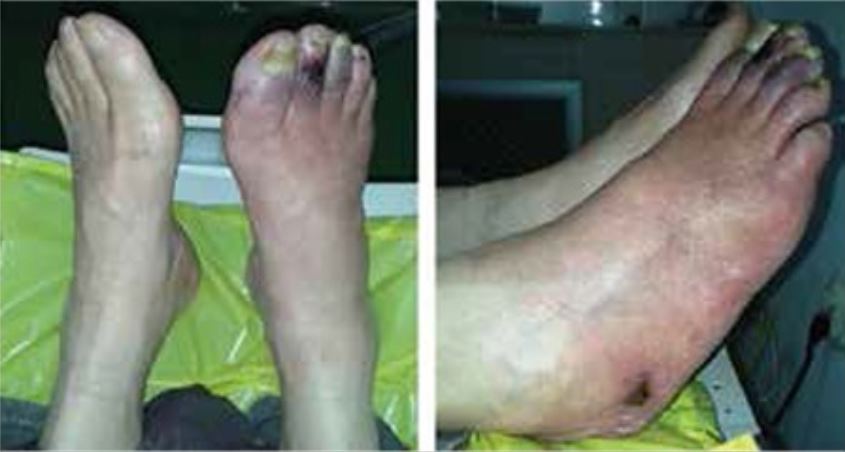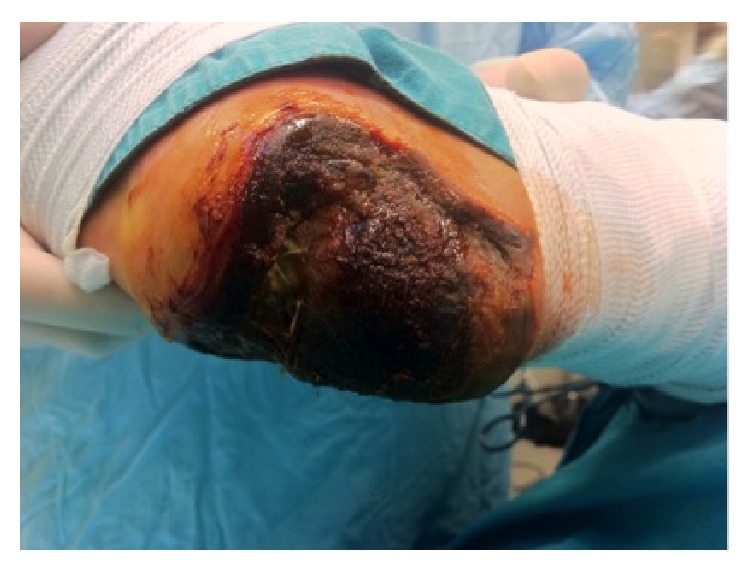Acute limb ischemia (ALI) is a major vascular emergency because of the rapid decrease in limb perfusion that causes a potential threat to limb viability. The majority of cases are caused by arterial thrombosis due to plaque progression or embolism, but ALI can also be caused by blockage of venous drainage. The typical signs and symptoms of ALI are often referred to as the 6 Ps: pain, pallor, poikilothermia, paralysis, paresthesia, and pulselessness. The diagnosis is made on the basis of clinical findings and Doppler studies, but additional imaging may be required. Management is focused on revascularization. IV heparin is also administered. Nonviable limbs require amputation.
Last updated: Mar 4, 2024
Acute limb ischemia Ischemia A hypoperfusion of the blood through an organ or tissue caused by a pathologic constriction or obstruction of its blood vessels, or an absence of blood circulation. Ischemic Cell Damage (ALI) is a vascular emergency Vascular Emergency Acute Limb Ischemia caused by a rapid decrease in limb perfusion. Symptom duration is < 2 weeks following the acute event.
Features[1,4–7,14]

Skin changes and ulcers in a patient with type 2 diabetes mellitus and peripheral artery disease
Image: “Skin ulcers on the right foot” by Manevska N, Gjorceva DP, Ahmeti I, Todorovska L, Stojanoski S, Kocovska MZ. License: CC BY 2.5
Unrecognized hand ischemia after intraarterial drug injection:
Note the significant bluish discoloration of the ischemic right hand distal to the wrist. The patient presented with hypoesthesia distal to the wrist crease and a pathologic Allen test.

Full-thickness necrosis of the heel due to acute limb ischemia in a diabetic patient
Image: “Full thickness necrosis due to acute limb ischemia” by Bingol UA, Cinar C, Arslan H, Altındas M. License: CC BY 3.0Acute limb ischemia Ischemia A hypoperfusion of the blood through an organ or tissue caused by a pathologic constriction or obstruction of its blood vessels, or an absence of blood circulation. Ischemic Cell Damage is diagnosed on the basis of medical history, clinical presentation, physical examination, and vascular imaging.[1,5]
Assess for the 6 Ps PS Invasive Mechanical Ventilation:
Other possible findings:
Clinical assessment:
| Category | Sensory Sensory Neurons which conduct nerve impulses to the central nervous system. Nervous System: Histology Changes | Motor Motor Neurons which send impulses peripherally to activate muscles or secretory cells. Nervous System: Histology Changes | Doppler Doppler Ultrasonography applying the doppler effect, with frequency-shifted ultrasound reflections produced by moving targets (usually red blood cells) in the bloodstream along the ultrasound axis in direct proportion to the velocity of movement of the targets, to determine both direction and velocity of blood flow. Ultrasound (Sonography) Signal:Arterial | Doppler Doppler Ultrasonography applying the doppler effect, with frequency-shifted ultrasound reflections produced by moving targets (usually red blood cells) in the bloodstream along the ultrasound axis in direct proportion to the velocity of movement of the targets, to determine both direction and velocity of blood flow. Ultrasound (Sonography) Signal: Venous |
|---|---|---|---|---|
| I: viable | None | None | Audible | Audible |
| IIa: marginally threatened | Minimal (toes) or none | None | Often inaudible | Audible |
| IIb: immediately threatened | Involves more than toes, pain Pain An unpleasant sensation induced by noxious stimuli which are detected by nerve endings of nociceptive neurons. Pain: Types and Pathways at rest | Mild to moderate | Inaudible | Audible |
| III: irreversible | Anesthetic | Paralytic | Inaudible | Inaudible |
Anatomic assessment and additional studies:[6,7]
| Imaging | Advantages | Disadvantages |
|---|---|---|
| Doppler Doppler Ultrasonography applying the doppler effect, with frequency-shifted ultrasound reflections produced by moving targets (usually red blood cells) in the bloodstream along the ultrasound axis in direct proportion to the velocity of movement of the targets, to determine both direction and velocity of blood flow. Ultrasound (Sonography) US | ||
| CTA CTA A non-invasive method that uses a ct scanner for capturing images of blood vessels and tissues. A contrast material is injected, which helps produce detailed images that aid in diagnosing vascular diseases. Pulmonary Function Tests | ||
| MRA-CE | ||
| DSA |

Intraoperative angiogram:
A: Superficial femoral and popliteal artery occlusion
B: Femoropopliteal predilatation
C: Postprocedural result after plaque excision with TurboHawk
Management can vary according to location. The following information is based on US and European medical society recommendations.
Immediate recognition of ALI[6,7]
Treatment approach
The treatment approach depends on the severity or category of ischemic injury.
Decision-making according to severity
Follow-up[7]
Complications[5–7]
ALI in other clinical situations